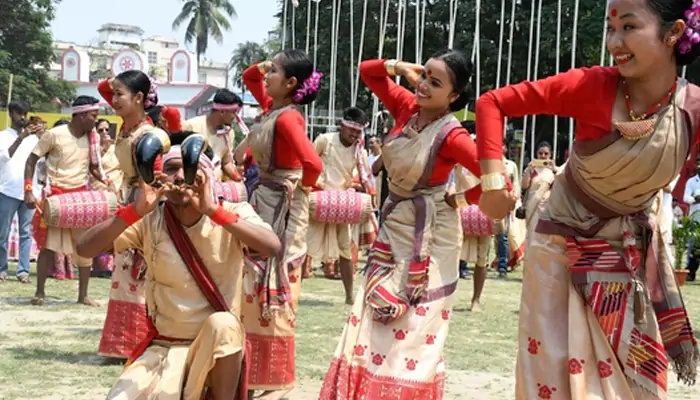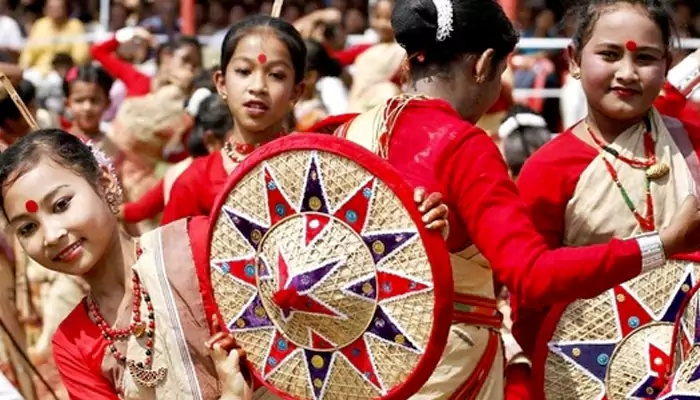
Bohag Bihu isn’t just a festival—it’s a riot of colors, culture, and tradition! Dive into the vibrant hues of Rongali Bihu attire and discover what makes these outfits so special.
Bohag Bihu, also known as Rongali Bihu, is Assam’s most vibrant festival, marking the Assamese New Year and the arrival of spring. And what’s spring without a burst of colors? Traditional attire plays a huge role in the celebrations, adding to the joy, energy, and cultural pride of the season.
From the bright red Gamosa to the intricate Mekhela Chador, every piece of clothing tells a story. So, let’s take a closer look at why these outfits matter and how they bring the spirit of Bihu to life!
Clothing isn’t just about looking good during Bihu—it’s about identity, tradition, and celebration. The festival is all about renewal, joy, and community, and the clothes people wear reflect that.
Think about it: when you see someone in a crisp Dhoti or a flowing Mekhela Chador, you instantly know—it’s Bihu time! These outfits aren’t just fabric; they’re a connection to heritage, a nod to craftsmanship, and a way to keep traditions alive.

The Mekhela Chador is the crown jewel of Assamese women’s wear during Bihu. It’s a two-piece outfit—a skirt (Mekhela) wrapped around the waist and a draped cloth (Chador) over the upper body.
What makes it special? The intricate patterns, usually inspired by nature—flowers, leaves, and geometric designs woven with precision. The colors are bright and lively, mirroring the festive mood. Reds, yellows, greens, and whites dominate, symbolizing prosperity, purity, and new beginnings.

For men, the classic Dhoti paired with a Kurta or Sherwani is the go-to Bihu attire. The Dhoti is a long, unstitched cloth wrapped around the waist, while the Kurta adds a formal yet festive touch.
White is a common choice, symbolizing purity, but you’ll also see men in bold colors like red, golden yellow, or deep blue, especially during Bihu dances. The simplicity of the Dhoti contrasts beautifully with the energy of the celebrations.

Ah, the Gamosa—this humble piece of cloth is everywhere during Bihu! It’s a white rectangular cotton towel with red borders and traditional motifs. But don’t be fooled—it’s not just for wiping hands.
The Gamosa is a symbol of respect, honor, and Assamese culture. It’s offered to elders, worn around the neck during Bihu dances, and even used as a waistband. Some are intricately woven, making them prized possessions.
No traditional Bihu outfit is complete without jewelry. Women often wear:
These pieces aren’t just accessories—they’re heirlooms, passed down through generations, adding elegance to the vibrant attire.

Ever wondered why certain colors dominate during Bihu? Here’s the scoop:
These colors aren’t random—they’re deeply tied to Assam’s agrarian roots and the spirit of renewal that Bihu celebrates.
In today’s world of fast fashion, traditional Bihu attire stands out as a beautiful reminder of Assam’s rich heritage. Younger generations are embracing these outfits with pride, mixing traditional weaves with contemporary styles.
Handloom artisans play a huge role in keeping these traditions alive. Every Mekhela Chador or Gamosa is a labor of love, woven with skills passed down through centuries.
Bohag Bihu is more than feasts and dances—it’s a celebration of identity, and clothing is a big part of that. Whether it’s the swirl of a Mekhela Chador or the crisp fold of a Dhoti, every outfit adds to the festival’s magic.
So next time you see someone dressed in traditional Assamese attire during Bihu, take a moment to appreciate the craftsmanship, history, and meaning behind it. After all, keeping traditions alive is what makes festivals like Bihu so special! Happy Bihu, and may your celebrations be as colorful as your clothes!